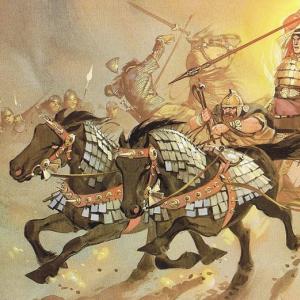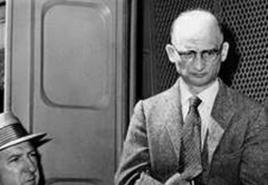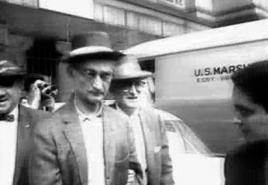Aristotle travel and geographical discoveries. Biography of Aristotle: briefly about the ancient Greek philosopher
Aristotle is the greatest philosopher of ancient Greece, the founder of the peripatetic school, a scientist. Favorite student of Plato and mentor of Alexander the Great is also Aristotle.
Biography briefly for children: about adolescence
In 384 BC. e. in Stagira, a Greek colony near Mount Athos, Aristotle was born - one of the great philosophers of all times and peoples.
The parents of the future scientist, who was often called Stagirite, were of noble birth. Nikomakh, the father of the future scientist, a hereditary healer, served as a court doctor and taught his heir the basics of medical art and philosophy, at that time inseparable from medicine. From childhood, Aristotle was closely associated with the Macedonian court and knew perfectly well his peer, the son of King Amyntas III, Philip.
As a child, Aristotle was orphaned and was raised by a relative of Proxenus. The latter put on his shoulders the care of the young man: he helped in getting an education, encouraged the teenager's curiosity in every possible way, spent money on the purchase of books, which at that time were a very expensive pleasure, almost a luxury. The fortune left after the death of parents favored such expenses. The biography of Aristotle, a summary of which arouses genuine interest among modern youth, truly inspires deep respect for this man, who has laid on his shoulders the responsibility for enlightening the rest of the people interested in the favorable future of their country.
Plato is my friend
Biography of Aristotle briefly tells how, for the purpose of studying philosophy in 367 BC. e. Aristotle moved to Athens, where he stayed for two decades. In the famous Greek city, the young man entered the Academy, opened by the great philosopher Plato. The mentor, drawing attention to the brilliant mental qualities of the student, began to distinguish him from the rest of the audience.

Aristotle gradually began to deviate from the views and ideas of his teacher and rely on his own worldview. Plato did not like this very much, however, the difference in views did not affect the personal relations of the two geniuses. Most of all, the opinions of the two great minds differed in the doctrine of the ideas that, as Plato believed, formed the disembodied world. For his student Aristotle, ideas were just the essence of occurring material phenomena, clothed in these very ideas. Concerning this dispute, Aristotle voiced a well-known phrase, which sounds in an abbreviated version as: "Plato is my friend, but the truth is dearer." Aristotle's incredible reverence for his beloved mentor Plato can be judged by the fact that the young man, who already had an established system of worldview, and therefore the prerequisites for organizing his philosophical school, did not do this during the life of a mentor.

Aristotle's biography briefly describes that in 347 BC. e., after the departure of another great teacher into the world, his place as the head of the Academy was taken by his nephew Speusip. Aristotle, being dissatisfied with this circumstance, left Athens and, at the invitation of the tyrant Hermias (a student of Plato), went to the city of Assos, located in Asia Minor. After 2 years, for active opposition to the Persian yoke, Hermias was betrayed and crucified, in connection with which Aristotle had to leave Assos in a hurry. Also fled Pythias - a relative of Hermia, who later became the wife of the Greek philosopher. A refuge for a young couple was found in the city of Mytilene (Lesvos island). It was here that Aristotle was invited to become the mentor of Philip's son, Alexander, at that time a 13-year-old teenager.
About Aristotle's pupil
The biography of Aristotle briefly shows that the influence of the Greek philosopher on the character of his student and the way of his thoughts, to which the fame of the greatest commander was later entrenched, was enormous.

Aristotle, skillfully tempering the passion of his ward's soul, guided the young man to serious thoughts, awakened noble aspirations for feats and glory, instilled a love for the Iliad, the book of Homer that accompanied Macedonian throughout his life. Alexander received a classical education in which the emphasis was on the study of politics and ethics. Also, the young commander was well versed in literature, medicine and philosophy.
Foundation of the school
The biography of Aristotle briefly tells how the Greek philosopher, leaving his nephew Callisthenes with Macedonian, in 335 BC. e. returned to Athens, where he founded the philosophical school Lyceum (lyceum), otherwise called "peripatetic" (from "peripathos" - a covered gallery around the courtyard, a walk). This characterized the place of the lessons or the manner of the teacher in the process of presenting information - walking back and forth. Representatives of the Peripatetic school, along with philosophy, were engaged in various sciences: physics, geography, astronomy, history. The morning classes, called "acroamatic", were attended by the most prepared pupils, after dinner anyone could listen to the philosopher.

This period in the biography of the Greek philosopher is a crucial stage, because it was at this time that many important discoveries were made in the process of research and a colossal part of the works was created, which largely determined and directed the development of world science in the right direction. During these years, his wife Pythias died. The second time Aristotle married her former slave, Gerpillis.
last years of life
The biography of Aristotle briefly and clearly describes that the ancient Greek philosopher, enthusiastically occupied with the world of science, was completely far from political events, but after the death of Alexander the Great in 323 BC. e. a wave of anti-Macedonian persecution and repression began in the country, the sky thickened over the head of the Greek philosopher. Aristotle was charged with disrespect to the gods and blasphemy, which forced the scientist, who understood the bias of the upcoming trial, to leave with some students for Chalkis, on the island of Euboea, which became the last refuge in his life. The 62-year-old philosopher died of a hereditary stomach disease. As head of Lyceum, Aristotle was replaced by his best student Theophrastus. The family of the great scientist was continued by his daughter Pifiala (the son of Nicomachus, according to some assumptions, was killed in the war in his youth).
Aristotle: a short biography and his discoveries
There is an opinion that the great Aristotle was a short and sickly man. His speech was very fast and defective: the philosopher mixed some sounds, which in no way diminished his tremendous contribution to science.
Like most thinkers of ancient times, in addition to philosophy, Aristotle was diligently engaged in various sciences and became the founder of some sections: logic, scientific rhetoric, grammar. Also, the great thinker established a large number of important facts in anatomy and zoology, was the first to create the philosophy of art and the theory of poetry. The most important and famous works of Aristotle are "Politics", "Metaphysics", "Poetics", "Physics". The philosophical system of the Greek enlightener affected various aspects of humanity and globally influenced the subsequent development of scientific thinking.
In geography, Aristotle expressed the idea of \u200b\u200bthe integrity and infinity of the World Ocean. In biology, the scientist described about half a thousand species of animals and founded a zoological systematics, the first in scientific history. Studying animals, I divided them into 2 groups: bloodless and animals with blood (put a man at the head), which practically corresponds to today's concept: vertebrates and invertebrates. The great philosopher is considered the father of meteorology (this term was first mentioned in a treatise on celestial phenomena).
Of all the works of Aristotle, only one fourth of the works have survived to this day. According to some assumptions, the rich library of the philosopher after his death passed to Theophrastus and his descendants, who, being uneducated people, dumped the books into boxes and locked them in the basement. Dampness and worms finished what they started.
Plato and Aristotle. Contribution to geography
Plato (428–348 BC) and Aristotle (384–322 BC), two famous ancient Greek philosophers, made important contributions to the development of geographical thought. Plato, being the founder of the deductive method, had an excellent mastery of deductive conclusions; proceeding from them, he argued that all things and phenomena observed on Earth are only pale copies of ideas, or perfect (absolute) prefects, since they are a defective product of the latter's transformation or are in the process of such a transformation (Popper, 1945/1962: 18 –34). Once, he reasoned, Attica (a territory within the boundaries of Ancient Greece, whose main city was Athens) had very fertile soils that ensured a comfortable existence for its inhabitants. The mountains were covered with forests, which not only fed the animals that lived in them, but also kept rainwater under their shade, preventing them from draining uselessly down the slopes into the rivers. “The water did not disappear, as it does now, sliding into the sea on the bare land ... What has survived, if you compare it with what existed before, looks like the emaciated body of a sick person; all the fertile, soft lands were wasted and disappeared, leaving only the skeleton of the land ”(Glacken, 1967: 121). Explaining a particular situation in Attica from the standpoint of a general theory, Plato uses this as an example of the decline, or rebirth, of things and phenomena in comparison with their original perfect state. If Plato's reasoning went from the particular to the general, he could come to the conclusion that it was people who changed the appearance of the land on which they settled, and that soil erosion and destruction of natural landscapes accompany the history of human civilization, re-revealing themselves in many places on Earth ... But the idea of \u200b\u200bman as an agent of transformations on the earth's surface, even thousands of years after Plato, was still not formulated. As Glacken points out, Plato missed the opportunity to change the entire history of the development of ideas about the relationship between man and nature, without seeing her destroyer in man.
The name of Plato is associated with the legend of Atlantis. The Greek world, he said, was nearly conquered in 9000 BC. e. people who had a high civilization and lived somewhere in the west. But the Greek army emerged victorious in a fierce battle. In addition, immediately after the defeat of the conquerors, their homeland was destroyed by a catastrophic earthquake and plunged into the depths of the sea. One could even swim over the flooded city of Atlantis, he argued, as long as one was very careful not to run aground. Since then, researchers and popularizers have been looking for Atlantis. Some of them even imagined the existence of a land bridge between Africa and America (on which a mysterious civilization was supposedly located). Only in 1966 another hypothesis began to take shape, based on the fact that a submerged city was discovered in the Mediterranean Sea between the island of Crete and the mainland of Greece - it could well be the very Atlantis that Plato spoke of.
Is the Earth round or flat? The overwhelming majority of people who lived in those days did not doubt that the earth was flat; only a few philosophers, based on purely theoretical premises, believed that the Earth has the shape of a ball. All Greek thinkers agreed that symmetrical form is one of the attributes of perfection, and the sphere has the most complete symmetry. Consequently, they argued, the Earth, created with a perfect shape, in its capacity as a home for people, should be spherical. Pythagoras, who lived in the VI century. BC e. may have been the first of the philosophers to hold this point of view. In any case, he developed the mathematical laws of the circular motion of celestial bodies, and his student Parmenides applied them to observations made from the surface of the spherical Earth. As for Plato, who lived a century later than Parmenides, he was, apparently, the first of the philosophers to put forward the hypothesis of a spherical Earth located in the center of the universe with celestial bodies revolving around it. True, it is not possible to establish exactly whether Plato was the author of this hypothesis or whether he borrowed it from Socrates, to whom he refers. A contemporary of Plato, Eudoxus of Cnidus (400–347 BC), created a theory of climatic zones based on the concept of an increasing inclination (klima) of the sun's rays relative to the spherical surface of the Earth. These conclusions were the product of deductive conclusions from the theory, according to which all things and phenomena accessible to observation are created as samples of a perfect form, and the sphere has the most perfect form. And only Aristotle first began to look for real evidence that could support the theory.
Aristotle was seventeen years old when he entered the Academy of Plato near Athens. Then (367 BC) it was temporarily headed by Eudoxus, replacing the absent Plato. Aristotle remained at the Academy until he was thirty-eight years old, until the death of Plato. He spent the next twelve years traveling in Greece and sailing along the Aegean coast. In 335 BC. BC, when he was forty-nine years old, he returned to Athens and founded his own school there, calling it Lyceum. By this time he was convinced that the best way to build a theory is through observation of facts, and the best way to test a theory is to compare it with the results of observation. Whereas Plato intuitively created a theoretical construct and thought, following from the general to the particular, Aristotle in the process of theorizing went from the particular to the general. These two approaches are respectively called deduction and induction.
Aristotle found that observations made available to us through the senses are not in themselves capable of explaining anything. Our senses, he said, can tell us that fire is hot, but they cannot tell us why it is hot. Aristotle deduced four basic principles of scientific knowledge, which are given in the form of answers to the question: "What is this object and why does it exist?" The first principle consists in describing the nature, or essence, of the object under consideration, which allows us to identify its main features. The second is in determining the nature, the type of substance from which it consists. The third recommends to establish what triggers the process as a result of which the object becomes what it is. The fourth, complementary to the third, should reveal the purpose of the implementation of the object. In contrast to Plato, Aristotle believed that things and phenomena are in the process of physical change, leading to the final perfect state. This model of scientific explanation is the world's first paradigm that should guide all scientists.
In his views on matter, or the basic substance, from which all material bodies are built, Aristotle followed Empedocles (490-430 BC). Empedocles, who lived a century earlier than Aristotle, took a step forward in comparison with the views of Thales of Miletus about a single primary substance (water). He distinguished four primary substances: earth, water, fire and air. According to him, all bodies on Earth consist of these main elements, which are present in them in different proportions. Aristotle added a fifth substance - ether; it is absent on Earth, but serves as the material from which celestial bodies are created.
Aristotle pointed out that every material object on Earth or outside it is created as a result of some process of change. In the beginning there was empty space. Philosophers of that time postulated the existence of two types of space - heavenly and earthly, or the space of the earth's surface. There were also several purely speculative conclusions about the inner space, but there was too little knowledge in this area. Aristotle, developing the ideas of Empedocles, proposed a theory of natural (natural) places. In the Universe, each body has its natural place and when it is removed from this place, this body will strive to return. Earthly space is a natural place for earth and water, and if you raise them above this surface, then they themselves and the substances that compose them will fall on it. Air and fire have natural places in heavenly space: that is why they tend upward. At the same time, the natural place of the ether is celestial bodies located far from the Earth.
Aristotle agreed with that part of the teachings of Plato, dating back to Pythagoras and Parmenides, in which it was said that all bodies obey the law of numbers, and the basic laws of the Universe are the laws of geometry and algebra (mathematics). However, he also expressed dissatisfaction, noting that "now all people think that science is mathematics and that in order to understand absolutely everything, it is only necessary to study mathematics." Aristotle argued that mathematics can be used to explain the process of change that makes things what they are, but it cannot answer the fourth question, goals or ideal states. Aristotle was the first teleologist in the sense that he was a staunch supporter of the view that everything in the world changes in accordance with a predetermined scheme or plan. All things, said Aristotle, do not move away from the ideal state, but, rather, on the contrary, develop in the direction of the ideal.
Sharing Plato's idea of \u200b\u200bthe sphericity of the Earth, Aristotle began to look for an explanation of this concept and ways to test it through observations. Its explanation was associated with the theory of natural places: the sphere was supposed to form when falling to the center point of the solid material from which the Earth is composed. Aristotle was the first scientist to understand the importance of observing the circular edge of the shadow cast by the Earth on the Moon during an eclipse for proving the sphericity of the Earth. He also noticed that the height of various stars above the horizon increases in a northerly direction - this can only be if the observer moves along with the convex surface of the sphere on which he is located. It is strange that he never once mentioned such an additional confirmation of the concept of the sphericity of the Earth, as the phenomenon of the disappearance of a ship beyond the horizon, when the hull disappears first, and then the sails. He should have had enough occasions to observe this phenomenon.
Aristotle's method of scientific explanation did not include any considerations about controlling experiments or testing preliminary conclusions. It was entirely built on the use of logic to formulate and confirm a theory. And yet, some of his logical explanations were considered in the 4th century. BC e. so irrefutable and were so unconditionally accepted by scholars of many subsequent generations that its influence on the history of Western thought was truly enormous. It is believed that modern science could not have appeared at all without Aristotle. Here I would like to note a very characteristic feature of the development of ideas: the emergence of any new concept has a tremendous stimulating effect on scientific thought and is expressed in an increase in the number and quality of observations, but its continued practice becomes an obstacle to the progress of science in the next generations of scientists.
In the field of geography, an example of this is Aristotle's concept of the different suitability of the Earth for human life, depending on the geographical latitude. People who lived along the shores of the Mediterranean Sea believed that the degree of the Earth's habitability depends on the geographical latitude, which seemed to be confirmed by observations. If the Earth is a sphere and the Sun revolves around it, then places where the Sun is almost directly overhead should be much hotter than places far from these conditions. And today, the absolute maximum temperature recorded in a standard weather booth and is 136.4 ° F (+ 58 ° C) remains behind one of the points of modern Libya, located 25 miles south of the Mediterranean Sea and more distant from the equator to the north than at 32 ° latitude. If the air warms up so much at this latitude, the Greeks reasoned, then it should be much hotter at the equator. People living in northern Libya have black skin, and the Greeks believed they were burned black in the hot sun. Consequently, life at the equator is impossible, since all living things would have burned there under the fiercely burning rays of the luminary. Aristotle therefore believed that the parts of the Earth adjacent to the equator (tropical zone) were uninhabited, as were the parts of the Earth farthest from it (polar zone), where eternal cold reigned; only the temperate zone enclosed between the two was the inhabited part of the Earth, or the Ecumene. However, she, said Aristotle, was not completely inhabited due to the existence of the ocean within its boundaries. Aristotle was convinced that there was a southern temperate zone, but the Greeks could not reach it because of the intolerable heat in the tropical zone. Many ancient scientists, who shared Aristotle's opinion about the existence of the southern temperate zone, were convinced that it was uninhabited, since the people there - the antipodes - would have to walk upside down. The concept of the degree of habitability as a function of latitude has a long history and is still widespread, especially among non-geographers.
List of references
- James P. All Possible Worlds / P. James, J. Martin / Ed. and with after. A.G. Isachenko. - Moscow: Progress, 1988 .-- 672 p.
The great ancient Greek philosopher and scientist created a comprehensive system of knowledge that covered almost all aspects of life in the ancient era. Aristotle made a huge contribution to science. So, it was he who created the foundation for political science as a separate science, and also compiled a classification of various types of state devices. And the first book on physical geography in history was Meteorology. The scientist compiled hierarchical levels of all the surrounding world known at that time. He divided everything that exists into 4 groups.
- Inorganic world;
- Plants;
- Animals;
- Man.
In this work, Aristotle makes a description of the Ecumene based on information about the world order, which was at the disposal of the ancient Greeks. He described mountain systems, mentioning the Pyrenees and Ripean Mountains in Europe, and the Silver and Atlas Mountains in Africa. The author also pays attention to the seas, reasoning on the topic - whether they always existed on Earth or were formed at some period of time, why the water in them is salty. He expresses curious ideas about sea currents. Aristotle explains their origin by the differences in the depths of the seas. This version was adhered to by other major scientists of antiquity - Eratosthenes, Straton.
In his work, Aristotle also hypothesizes the existence of a populated continent similar to Eurasia in the southern hemisphere. His reflections on the nature of winds are of interest. The author gives a diagram of a 12-ray wind rose. To each wind it gives its name, according to the place from which it blows. A similar principle and the wind rose itself was used until the early Middle Ages. Summarizing the experience and knowledge of all scientists of his time, the thinker reflects on the origin of such natural phenomena as earthquakes, thunder, hurricanes, and also describes false suns and halos. I. D. Rozhansky considers Aristotle's work as the first attempt to create a complete theoretical concept and explanation of the surrounding world from a rational point of view.
Another work of Aristotle "On Heaven" is devoted to the structure of the Universe. According to the scientist, space is limited spatially, but infinite in time. There are several belts - hot - which is bounded by the line of the tropics and two cold - which extend to the line of visible stars. Moderate inhabited zones are located between cold and hot zones. Thus, one of them is located in the Northern Hemisphere, the other in the Southern. The entire body of knowledge of Ancient Greece was collected and summarized in the works of Aristotle. His work had a tremendous impact on the development of science and the entire civilization.
Geographer Robert Grossetest
The English scientist Grossetest is one of the foremost thinkers in the natural sciences. His activity falls on the first half of the XII century. The scientist knew several languages, including Greek, Arabic and Latin. It was he who began to translate into Latin from the ancient Greek works of Aristotle. Grossetest is considered the founder of the Oxford School of Philosophy, which placed great emphasis on the study of natural science. Also, the scientist actively studied optics, astronomy and other sciences.
His method of cognition was based on the logical scheme of Aristotle. Grossetest developed his own concept of "metaphysics of light". According to her, light is an elusive self-propagating substance. This is the primary form of energy. The scientist assumed that for the emergence of the entire Universe, a sufficient condition would be the creation of a single point by God, one of the forms of which would be light. Further self-propagation from this point of energy leads to the creation of the Universe. Light is the universal and primary carrier of any action that is possible in the world. The main role in the study of natural phenomena, according to Grossetest, is played by mathematics. After himself, the scientist left a whole lot of works that left a bright mark in the history of science. Also known are his comments on the works of Aristotle, primarily on "Physics" and "Second Analytics".
Roger Bacon's views
Although Roger Bacon was a student of Grossetest, he became as famous as his mentor. Bacon's book "The Great Essay" is considered a real encyclopedia of scientific knowledge of its time. The scientist adhered to a natural-scientific worldview, criticized church customs and recognized authorities of scholastic thought. For this he was convicted and spent 12 years in prison. In the field of philosophy, Bacon put Aristotle in the first place, although he was critical of some of the ideas of the ancient Greek scientist. From the Arab scientists Ibn Rushd and Ibn Sina, Bacon adopted the idea of \u200b\u200bthe eternity of the world of matter and put forward the thesis that experience is the basis of all knowledge. The scientist attached great importance to the development of astronomy and mathematics. He considered mathematics to be the most accurate discipline and the real yardstick by which to check the data of other sciences.
One of the sections of the Great Essay is devoted to geography. Bacon claims that the Earth has the shape of a ball, like the ancient scientists, recognizes the existence of five heat zones, and he considers warm and cold zones as uninhabited. In his opinion, Europe is the largest part of the land, and India is located quite close to Europe and Africa and occupies about 1/3 of the solid surface of the Earth.
To determine the size of the globe, Bacon uses data that were obtained by Arab astronomers in 827 when calculating the meridian arc of 1 degree. The theory of the supposed proximity of the shores of India was known to Columbus when he planned his travels in order to find the shortest way to this country. In the work of Bacon there is a mention of the "Dome of the World". By this term, the scientist understood a point that is located at the same distance from the western and eastern boundaries of the land and both Poles. When describing exotic countries, Bacon borrowed many moments from Pliny, supplementing them with the available new information. The scientist mentions the tribe of Tatars in the "Great Composition" and describes the tents that this people uses as dwellings and huge herds of cattle.
He was able to obtain these facts from the work of Guillaume Rubruc, in which a journey to Central Asia was described. Bacon considered it wrong. Pliny's opinion that the Caspian Sea is a huge bay. In his opinion, the Caspian is a special sea, where many large rivers flow. Behind the distant river Tanais is the country of Rusia. There are many forests, inhabited by a tribe of Slavs who profess the Christian faith. He attributed the Tatar tribes to the pagans. This is a warlike tribe that has conquered many nations. Their priest is wise and knowledgeable in astronomy.
According to available information, Bacon wanted to create a complete map of all the countries known in his time, but he did not finish this work. Bacon advocated the reform of the Julian calendar, which was carried out 300 years later. After himself, the scientist left many works. Some of them were published during his lifetime, many were published after the death of the scientist. Some of the manuscripts exist only in the form of manuscripts and have not yet been published. Bacon was one of the brightest and most versatile scientists of the early Middle Ages and made an enormous contribution to the development of science and philosophy.
Geographical discoveries Is finding new geographic features or geographic patterns. In the early stages of the development of geography, discoveries related to new geographic objects prevailed. A particularly important role was played by the discoveries of previously unknown parts of the land (territorial discoveries). With the development of geography as a science, discoveries that contribute to the identification of geographical patterns, deepening knowledge of the essence of geographical phenomena and their interrelationships are gaining more and more importance.
Scientists find the rudiments of geographical knowledge among the peoples of the Ancient East - the inhabitants of Mesopotamia, Persia, Egypt, Phenicia. When crossing the deserts, when sailing on the seas, people learned to navigate by the Sun, Moon and stars. The ancient scientists of Mesopotamia first divided the circle into degrees, the year into 12 months, the day into 24 hours.
| Famous explorers | Years of research | Major achievements (geographical discoveries) |
|---|---|---|
| Egyptians | Trips to Central Africa. Sailing in the middle earth sea | |
| Phoenicians | The first to sail around Africa | |
| Herodotus | 5th century BC | He left a monument of ancient science "History in nine books" with geographical information. |
| Scientists of Ancient Greece | We identified 3 climatic zones: northern (Scythia), southern (Egypt and Arabia) and middle (Mediterranean). | |
| Aristotle | 4th century BC | He was the first to prove the sphericity of the Earth and the Moon. Author of "Meteorology" (the first work on physical geography) |
| Eratosthenes | 3rd century BC | He was the first to determine the size of the Earth along the meridian. Developed a way to build a map. Wrote "Geography" (Geography in 3 books) |
| Ptolemy | 2nd century AD | A guide to geography in 8 books is a collection of knowledge about geography of everything known to the ancient peoples of the world |
| Arabs | They founded colonies on the east coast of Africa, traveled to China and India. | |
| Normans | IX - XI centuries | Discovered and populated Iceland and Greenland. They reached the shores of North America. |
| Novgorodians | They reached the shores of the North Arctic Ocean, Grumant Island (Spitsbergen), reached the mouth of the Ob. | |
| Marco Polo | 1271-1295 | He was the first of the Europeans to visit China and many regions of Asia. He wrote a book about the nature of the Pamirs, monsoons of India, useful plants in China. |
| Afanasy Nikitin | 1466-1472 | The first Russian traveled to India and Arabia through Persia. |
| Bartolomeu Dias | 1488 | Explored the western and southern coasts of Africa |
| Christopher Columbus | 1492-1494 | Discovered America in 1492 - Bahamas, Greater and Lesser Antilles |
| Vasco da Gama | 1497-1499 | Opened a continuous sea route to India, circumnavigating Africa. |
| Vasco Nunez de Balboa | 1513-1525 | Crossed the Isthmus of Panama and reached the Pacific coast in America |
| Fernand Magellan | 1519-1522 | Under the command of this navigator, the expedition made the first round the world voyage |
| Francis Drake | 1577-1580 | Made a second round the world trip, discovered many geographical objects in different parts of the Earth |
| Abel Tasman | 1642 | Discovered New Zealand and Tasmania |
| Vitus Bering | 1741 | Discovered the northwest coast of North America |
| James Cook | 1768 -1779 | Discovered the east coast of Australia, Hawaii, the first explorer to cross the Antarctic Circle |
| Alexander Humboldt | 1799 -1804 | Comprehensively researched the nature of South America |
| F. F. Bellingshausen and M. P. Lazarev | 1819 -1821 | Discovered Antarctica and the adjacent islands |
| David Livingston | Ser. XIX century. | Conducted research in South and Central Africa |
| P.P.Semenov Tyan-Shansky | 1857 | Explored the Tien Shan mountains |
| N. M. Przhevalsky | 1870-1888 | Made four trips to Central Asia |
More information can be found in







